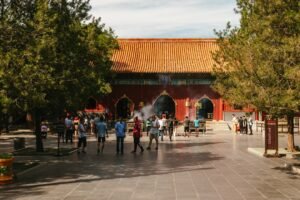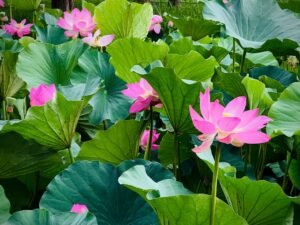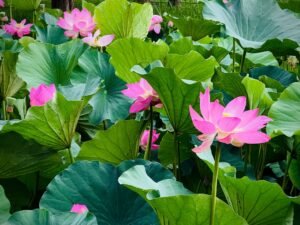

The Unspoken Joy: Why Learning Chinese is an Adventure for Your Mind and Soul
In the vast tapestry of human languages, each thread a unique conduit to a culture, a history, and a way of thinking, the vibrant, intricate thread of Mandarin Chinese stands apart. For many embarking on their linguistic journey, it can appear as a formidable challenge, a “Great Wall” of complex characters and subtle, shifting tones. But this perception, born from a distance, belies a profound and exhilarating truth. To learn Chinese is not to engage in a sterile academic exercise; it is to embark on one of the most rewarding adventures available to the modern mind. It is a journey that reshapes the very architecture of your brain, unlocks a civilization of breathtaking depth, and connects you to the hearts and minds of over a billion people. The narrative of difficulty has for too long overshadowed the sheer, unadulterated fun of it all—the playful discovery, the daily triumphs, and the deep, abiding joy of seeing the world through a completely new lens.
This is not a journey of rote memorization, but of vibrant, living discovery. It’s about the electrifying “aha!” moment when you decipher your first restaurant sign, the quiet pride in navigating a conversation with a taxi driver in Beijing, or the shared laughter with a new friend in Shanghai, all in their native tongue. While the challenges are undeniable, they are also the crucibles in which the greatest satisfaction is forged. The complexity is not a barrier; it is the very source of the adventure. And perhaps most surprisingly to the uninitiated, the grammatical structure of Mandarin is refreshingly direct and logical. Lacking the convoluted verb conjugations and gendered nouns of many European languages, it allows learners to begin constructing their own sentences and expressing their own thoughts with a speed that can be truly empowering. You are not just learning a language; you are unlocking a new dimension of your own potential.
A Playground for the Brain: The Cognitive Renaissance of a Mandarin Learner
Modern neuroscience is only just beginning to quantify what practitioners of the language have known for millennia: learning Chinese is a profound workout for the brain, fostering cognitive growth and agility in ways few other pursuits can match. The experience goes far beyond simple language acquisition; it is a catalyst for enhanced brain plasticity, the remarkable ability of our neural pathways to reorganize and strengthen in response to new experiences.
The primary engine of this cognitive renaissance is the tonal nature of the language. In English and other non-tonal languages, pitch and intonation primarily convey emotion or emphasis. In Mandarin Chinese, the tone is a fundamental component of a word’s definition. The syllable “shi,” for example, can mean “teacher” (shī), “ten” (shí), “history” (shǐ), or “to be” (shì), all depending on the tonal contour. This forces the learner’s brain to engage in a sophisticated level of auditory processing. Neuroimaging studies have revealed that native Mandarin speakers utilize both brain hemispheres more extensively for language processing, whereas speakers of non-tonal languages predominantly rely on the left hemisphere. For the learner, this bilateral engagement translates into a host of cognitive benefits. Your auditory perception becomes sharper, your ability to discern subtle sonic nuances is heightened, and your short-term memory, particularly for auditory information, shows marked improvement.
This cerebral workout extends powerfully to the realm of Chinese characters, or hànzì (汉字). Learning to read and write in Chinese is a multi-sensory experience that engages visual, spatial, and motor skills simultaneously. Unlike phonetic alphabets, where letters correspond to sounds, Chinese characters are logograms, where each symbol represents a word or concept. Many characters evolved from ancient pictographs, stylized drawings of the world around us. The character for “person” (人, rén) is a simple sketch of a walking figure. The character for “mountain” (山, shān) clearly evokes a range of peaks. This visual, almost artistic, element forges a stronger, more direct link between the symbol and its meaning, engaging the brain’s visual processing centers in a way that purely phonetic writing systems do not.
The true genius and fun of the system, however, lie in its combinatorial nature. Most complex characters are built from simpler components called radicals, which often provide a clue to the character’s meaning or pronunciation. Learning these radicals is like being given a set of linguistic Lego bricks. Consider the character for “good,” 好 (hǎo). It is a beautiful combination of the character for “woman” (女, nǚ) and the character for “child” (子, zǐ). The ancient logic suggests that a mother with her child is the embodiment of “goodness.” Or take the character for “rest,” 休 (xiū). It is composed of the radical for “person” (人, rén) leaning against the radical for “tree” (木, mù). The imagery is immediate and poetic: a person resting against a tree. Each new character becomes a puzzle to solve, a piece of history to uncover, and a story to tell.
This journey of discovery is not just about memorizing lists; it’s about understanding a system, seeing the patterns, and appreciating the elegance of its construction. Are you ready to embark on this exhilarating mental adventure? The NLS Norwegian Language School in Oslo provides a dynamic and supportive environment to explore the fascinating world of Mandarin. Begin your cognitive renaissance by registering for a class at https://nlsnorwegian.no/learn-chinese/.
A Culinary and Cultural Feast: Tasting the Language of a Civilization
One of the most immediate and delicious rewards of learning Chinese is the ability to dive headfirst into its world-renowned culinary landscape. Chinese food is not a monolith; it is a continent of flavors, a staggering diversity of regional cuisines each with its own history, philosophy, and unique vocabulary. Learning the language transforms you from a passive diner into an active culinary explorer.
Imagine walking into a bustling Sichuan restaurant, the air thick with the fragrant, tingly aroma of Sichuan peppercorns. With your growing vocabulary, you can confidently order dishes like mápó dòufu (麻婆豆腐) or dàndàn miàn (担担面), understanding the ingredients and the stories behind their names. You can discuss the concept of málà (麻辣), that signature numbing and spicy flavor profile, with the waiter. This is an experience that goes far beyond simply pointing at pictures on a menu; it’s a genuine cultural exchange, a connection forged through a shared love of food.
The language unlocks the secrets of the menu. You learn that 鱼香 (yúxiāng), or “fish-fragrant,” doesn’t actually contain fish but is a famous sauce from Sichuan cuisine. You learn the difference between 炒 (chǎo – stir-frying), 蒸 (zhēng – steaming), and 炖 (dùn – braising). Every meal becomes a language lesson, and every language lesson enhances your next meal. You can explore the delicate, refined flavors of Cantonese dim sum, the hearty, savory dishes of Dongbei (Northeastern) cuisine, or the subtle, artful presentations of Huaiyang cuisine.
Beyond the restaurant, learning Chinese opens your kitchen to a new world of possibilities. You can watch Chinese cooking shows, follow recipes from popular food bloggers like Li Ziqi, and understand the techniques in their original context. You can finally master the art of hand-pulled noodles or learn the secret to perfectly pleated dumplings, all while practicing your listening and reading skills in the most enjoyable way imaginable.
This cultural immersion extends far beyond the dining table. With Mandarin, you gain an all-access pass to one of the world’s most prolific and exciting entertainment industries. You can watch critically acclaimed films like “Farewell My Concubine” or modern blockbusters like “The Wandering Earth” without the filter of subtitles, catching the subtle wordplay and cultural nuances that are inevitably lost in translation. You can get hooked on epic television dramas, known as C-dramas, like “The Untamed” (陈情令, Chén Qíng Lìng) or “Nirvana in Fire” (琅琊榜, Lángyá Bǎng), and participate in online fan discussions with native speakers. The world of Mandopop, with its catchy tunes and heartfelt ballads, becomes your new favorite playlist, and singing along is a fantastic, pressure-free way to practice your tones and vocabulary.
Connecting with a Fifth of Humanity: The Social Superpower
In our increasingly globalized world, the ability to form genuine connections across cultural divides is not just a skill; it is a superpower. Learning Chinese offers you the key to communicating with nearly 1.5 billion people, a fifth of the world’s population. This is not about transactional communication; it’s about building bridges of understanding and forging friendships that can enrich your life in immeasurable ways.
Picture yourself traveling through the stunning landscapes of Yunnan province. Your ability to speak even basic Mandarin transforms your experience. You are no longer just an observer behind a camera lens. You can chat with a local tea farmer about the harvest, ask an elderly woman about the history of her village, or share stories with fellow travelers in a youth hostel. These are the spontaneous, authentic interactions that create lasting memories and provide a true window into the soul of a country. They are moments of connection that are simply inaccessible to the monolingual tourist.
Even at home in Oslo, learning Chinese opens up new social horizons. You can connect with the local Chinese community, participate in cultural events like the Chinese New Year festival, and build friendships with people you might never have otherwise met. Language exchange meetups, both online and in person, provide a fun and supportive environment to practice your skills while learning about someone else’s life and perspective. In these conversations, you’ll gain insights into crucial cultural concepts like guānxi (关系), the intricate web of social networks and relationships that is so central to Chinese society, or miànzi (面子), the concept of “face” or social honor. Understanding these ideas from the inside is a fascinating intellectual exercise and a practical tool for navigating social and professional situations with grace.
The journey of learning Chinese is an epic in itself. It’s a marathon that challenges your intellect, delights your senses, and expands your heart. It’s a commitment to growth, discovery, and connection. If you are ready to start this transformative adventure, the NLS Norwegian Language School in Oslo offers the perfect starting point, with experienced instructors and a curriculum designed to make learning both effective and deeply enjoyable. Take the first step on your path to fluency and fun by signing up here: https://nlsnorwegian.no/learn-chinese/.
The joy of learning Chinese is a cumulative one. It builds with every character you recognize, every tone you master, and every conversation you share. It’s an investment in yourself that pays dividends for a lifetime, opening up a world of intellectual stimulation, cultural richness, and human connection. The adventure awaits. Don’t hesitate to unlock this incredible world. The NLS Norwegian Language School in Oslo is ready to be your guide. Find out more and secure your place in a class today:
If you want to learn Norwegian, you can register for classes here. We look forward to hearing from you and helping you become fluent in Norwegian.





